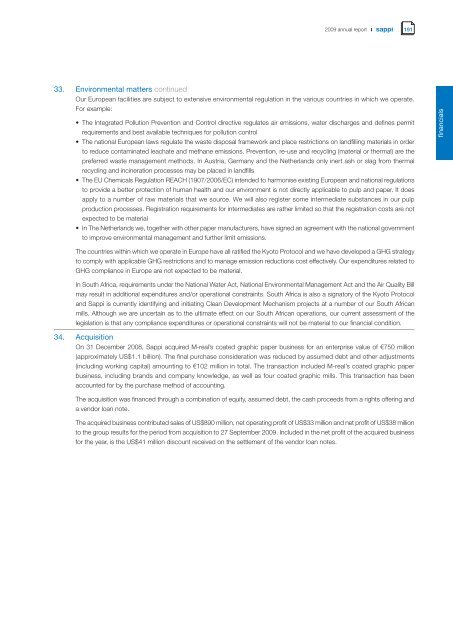Our performance in 2009 - Sappi
Our performance in 2009 - Sappi
Our performance in 2009 - Sappi
Create successful ePaper yourself
Turn your PDF publications into a flip-book with our unique Google optimized e-Paper software.
<strong>2009</strong> annual report<br />
33. Environmental matters cont<strong>in</strong>ued<br />
<strong>Our</strong> European facilities are subject to extensive environmental regulation <strong>in</strong> the various countries <strong>in</strong> which we operate.<br />
For example:<br />
• The Integrated Pollution Prevention and Control directive regulates air emissions, water discharges and def<strong>in</strong>es permit<br />
requirements and best available techniques for pollution control<br />
• The national European laws regulate the waste disposal framework and place restrictions on landfill<strong>in</strong>g materials <strong>in</strong> order<br />
to reduce contam<strong>in</strong>ated leachate and methane emissions. Prevention, re-use and recycl<strong>in</strong>g (material or thermal) are the<br />
preferred waste management methods. In Austria, Germany and the Netherlands only <strong>in</strong>ert ash or slag from thermal<br />
recycl<strong>in</strong>g and <strong>in</strong>c<strong>in</strong>eration processes may be placed <strong>in</strong> landfills<br />
• The EU Chemicals Regulation REACH (1907/2006/EC) <strong>in</strong>tended to harmonise exist<strong>in</strong>g European and national regulations<br />
to provide a better protection of human health and our environment is not directly applicable to pulp and paper. It does<br />
apply to a number of raw materials that we source. We will also register some <strong>in</strong>termediate substances <strong>in</strong> our pulp<br />
production processes. Registration requirements for <strong>in</strong>termediates are rather limited so that the registration costs are not<br />
expected to be material<br />
• In The Netherlands we, together with other paper manufacturers, have signed an agreement with the national government<br />
to improve environmental management and further limit emissions.<br />
The countries with<strong>in</strong> which we operate <strong>in</strong> Europe have all ratified the Kyoto Protocol and we have developed a GHG strategy<br />
to comply with applicable GHG restrictions and to manage emission reductions cost effectively. <strong>Our</strong> expenditures related to<br />
GHG compliance <strong>in</strong> Europe are not expected to be material.<br />
In South Africa, requirements under the National Water Act, National Environmental Management Act and the Air Quality Bill<br />
may result <strong>in</strong> additional expenditures and/or operational constra<strong>in</strong>ts. South Africa is also a signatory of the Kyoto Protocol<br />
and <strong>Sappi</strong> is currently identify<strong>in</strong>g and <strong>in</strong>itiat<strong>in</strong>g Clean Development Mechanism projects at a number of our South African<br />
mills. Although we are uncerta<strong>in</strong> as to the ultimate effect on our South African operations, our current assessment of the<br />
legislation is that any compliance expenditures or operational constra<strong>in</strong>ts will not be material to our f<strong>in</strong>ancial condition.<br />
34. Acquisition<br />
On 31 December 2008, <strong>Sappi</strong> acquired M-real’s coated graphic paper bus<strong>in</strong>ess for an enterprise value of €750 million<br />
(approximately US$1.1 billion). The f<strong>in</strong>al purchase consideration was reduced by assumed debt and other adjustments<br />
(<strong>in</strong>clud<strong>in</strong>g work<strong>in</strong>g capital) amount<strong>in</strong>g to €102 million <strong>in</strong> total. The transaction <strong>in</strong>cluded M-real’s coated graphic paper<br />
bus<strong>in</strong>ess, <strong>in</strong>clud<strong>in</strong>g brands and company knowledge, as well as four coated graphic mills. This transaction has been<br />
accounted for by the purchase method of account<strong>in</strong>g.<br />
The acquisition was f<strong>in</strong>anced through a comb<strong>in</strong>ation of equity, assumed debt, the cash proceeds from a rights offer<strong>in</strong>g and<br />
a vendor loan note.<br />
The acquired bus<strong>in</strong>ess contributed sales of US$890 million, net operat<strong>in</strong>g profit of US$33 million and net profit of US$38 million<br />
to the group results for the period from acquisition to 27 September <strong>2009</strong>. Included <strong>in</strong> the net profit of the acquired bus<strong>in</strong>ess<br />
for the year, is the US$41 million discount received on the settlement of the vendor loan notes.<br />
191<br />
f<strong>in</strong>ancials
















